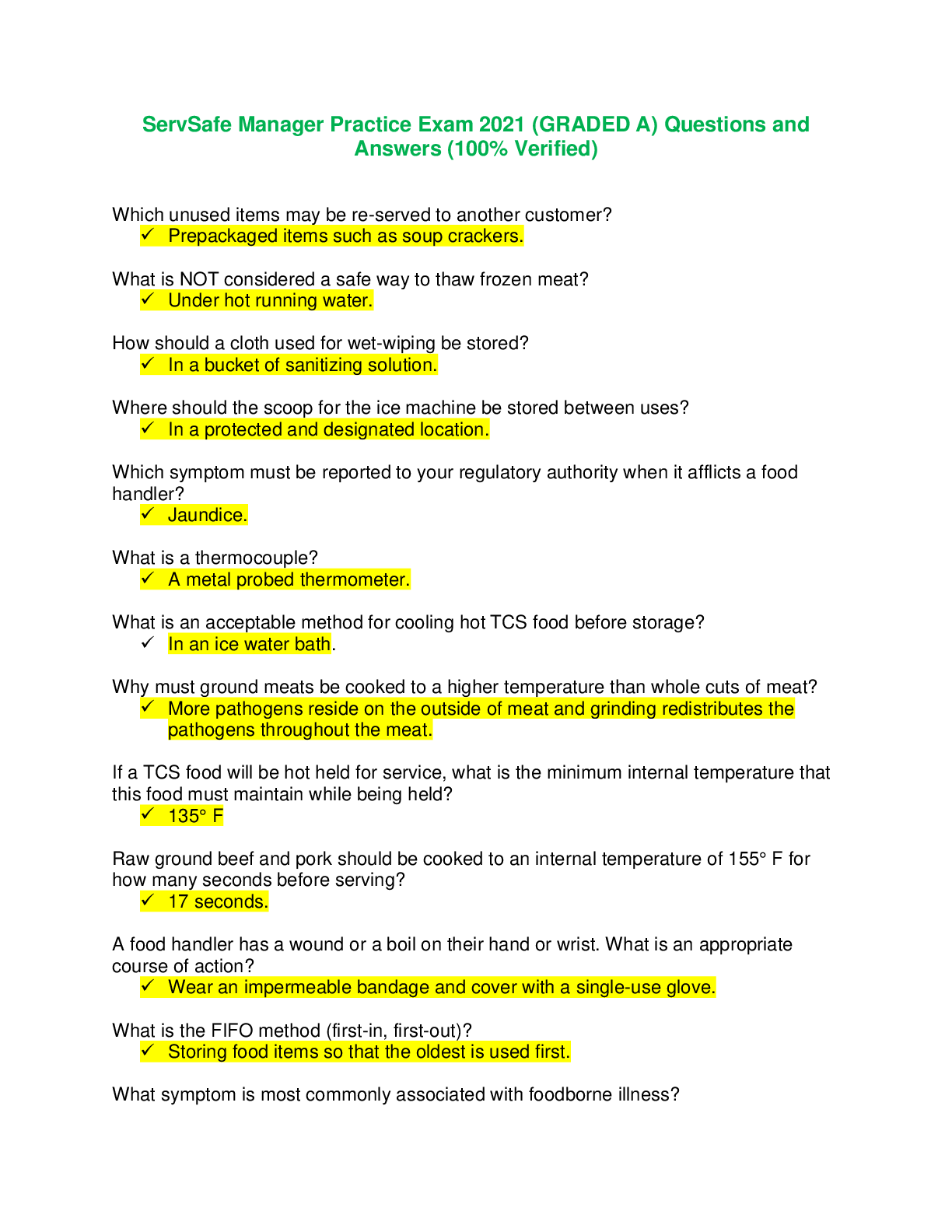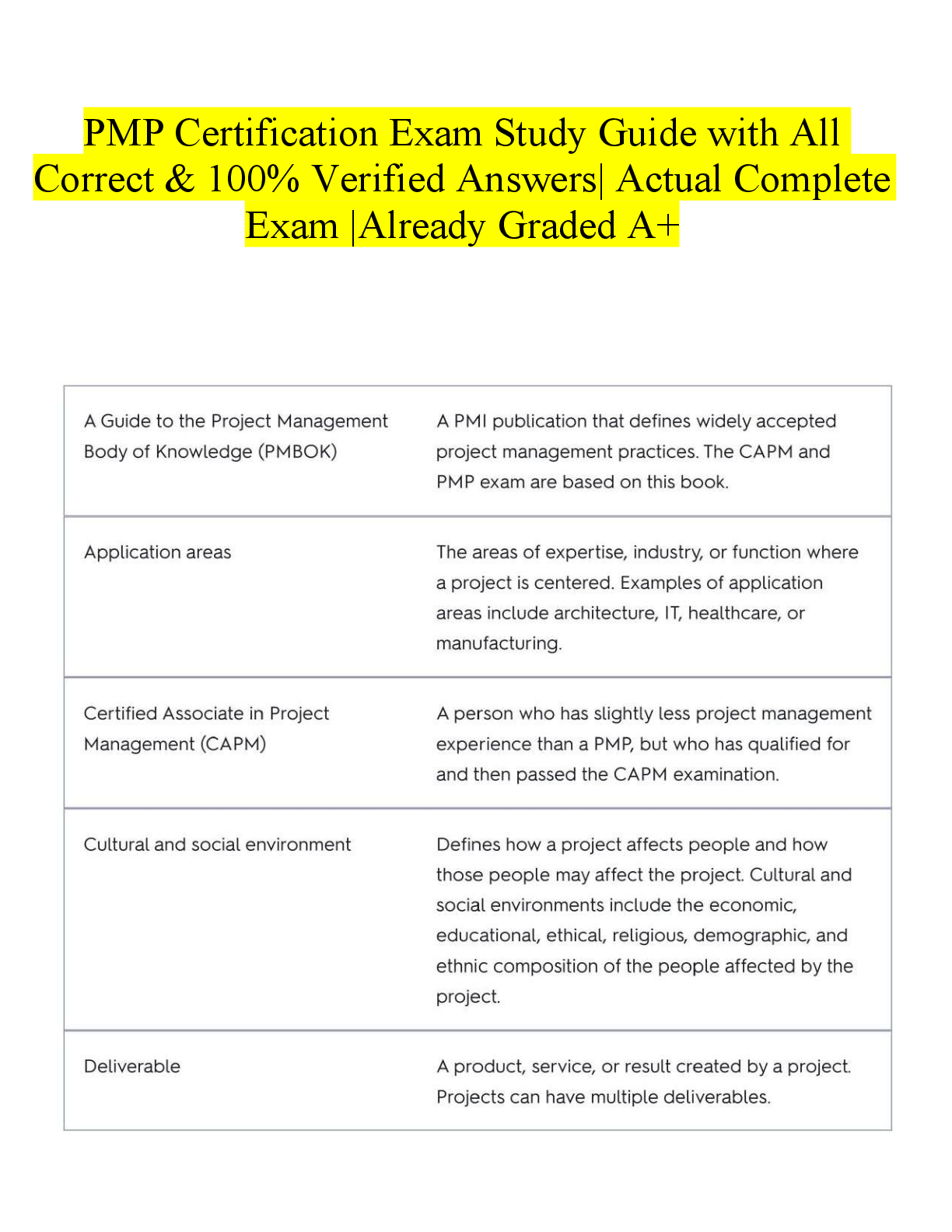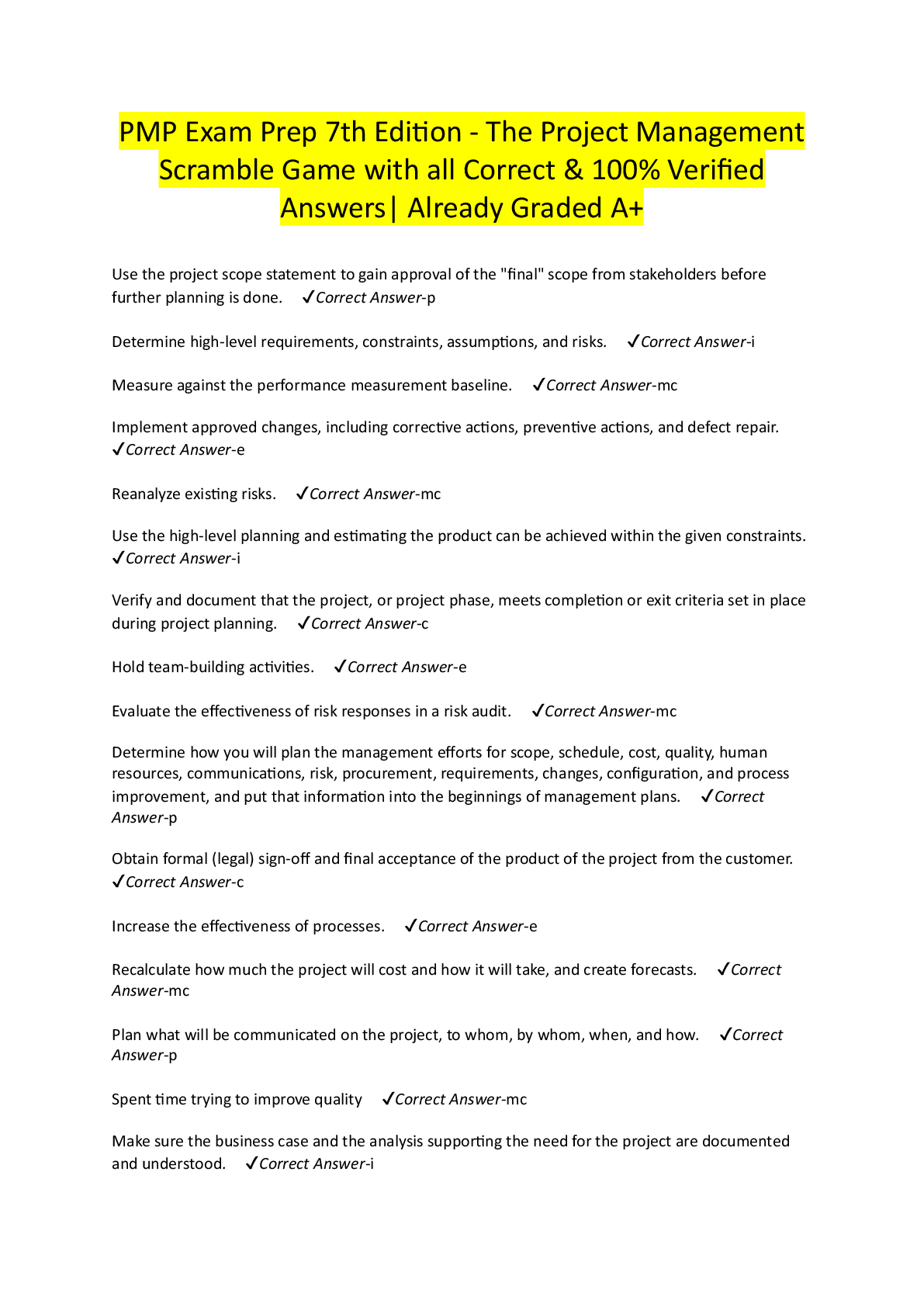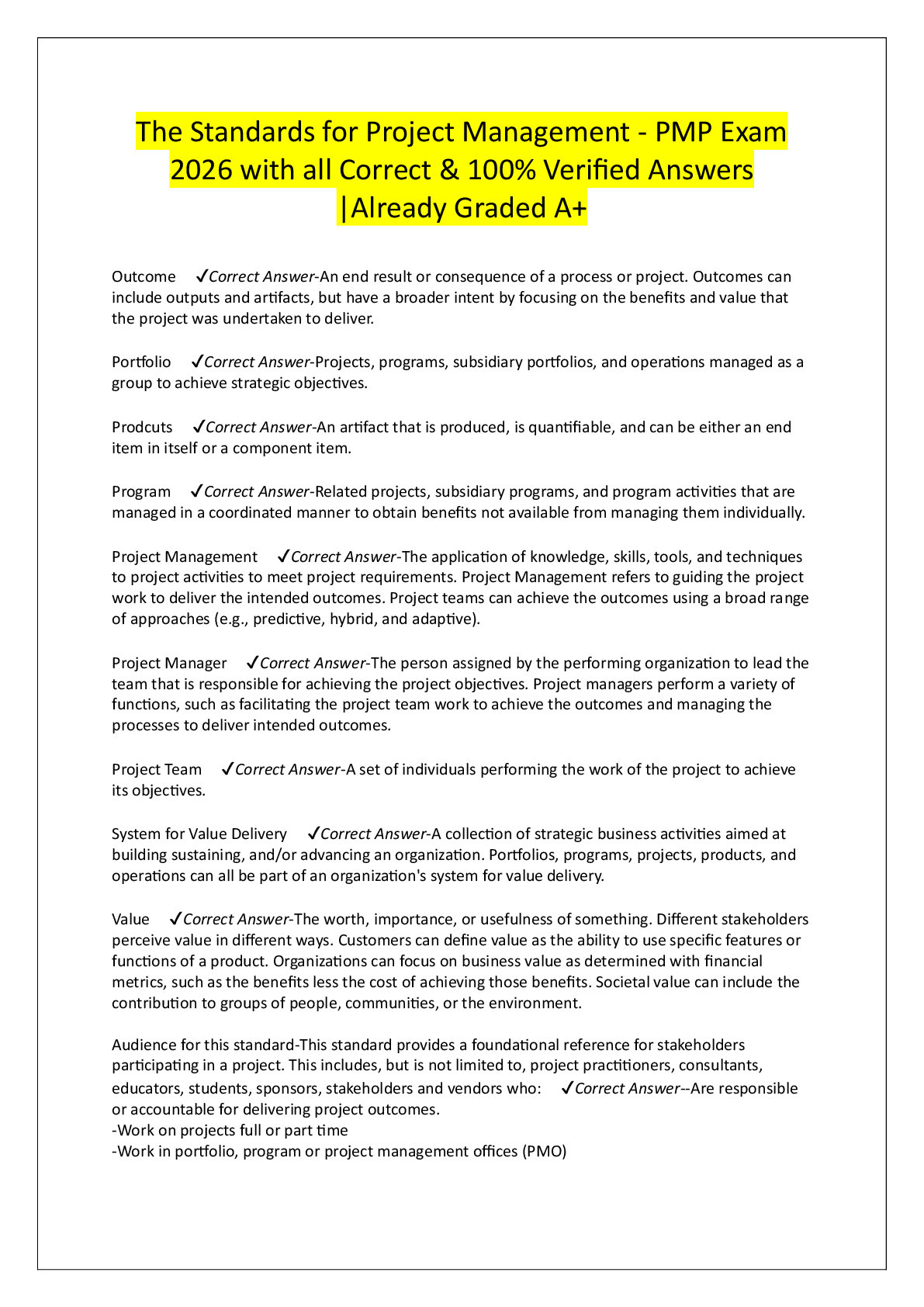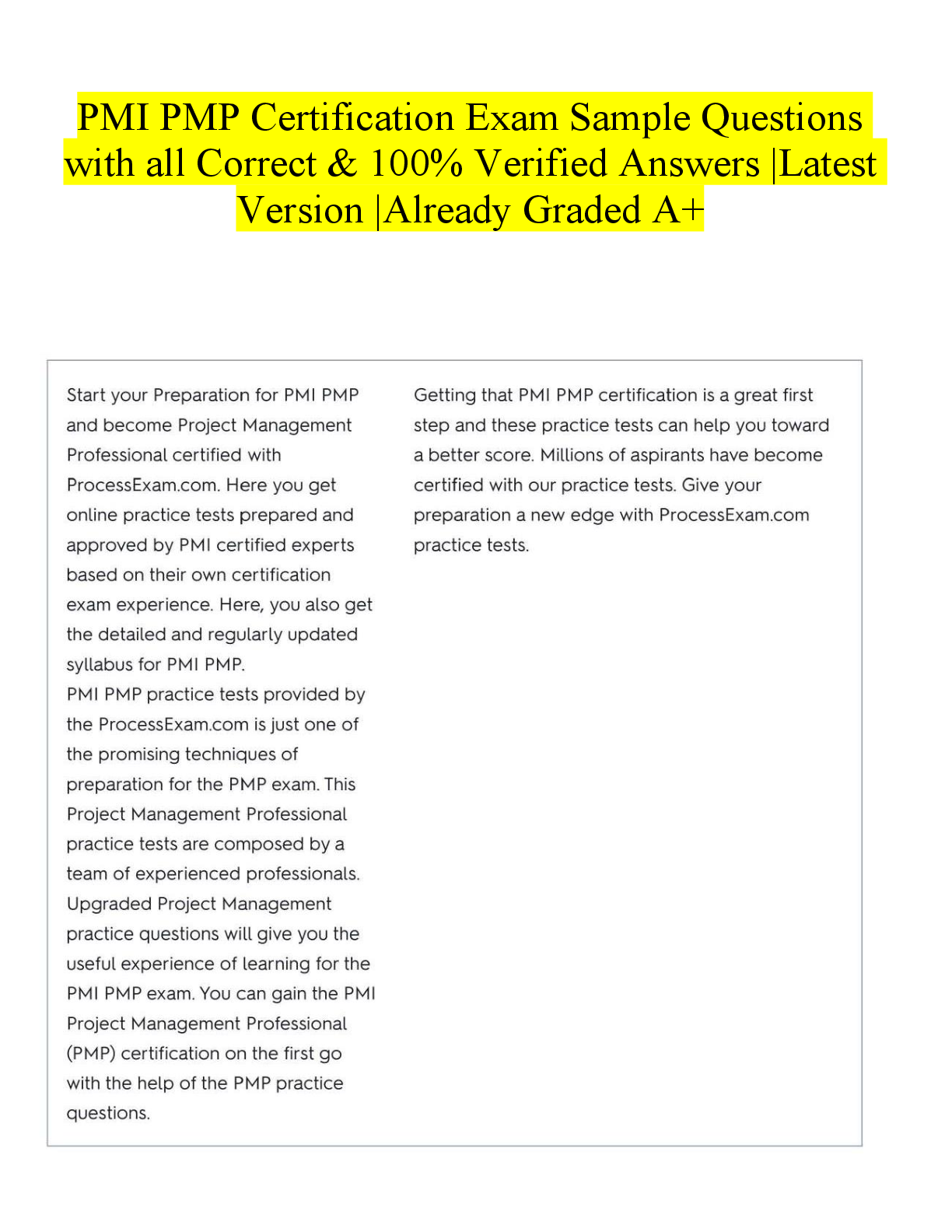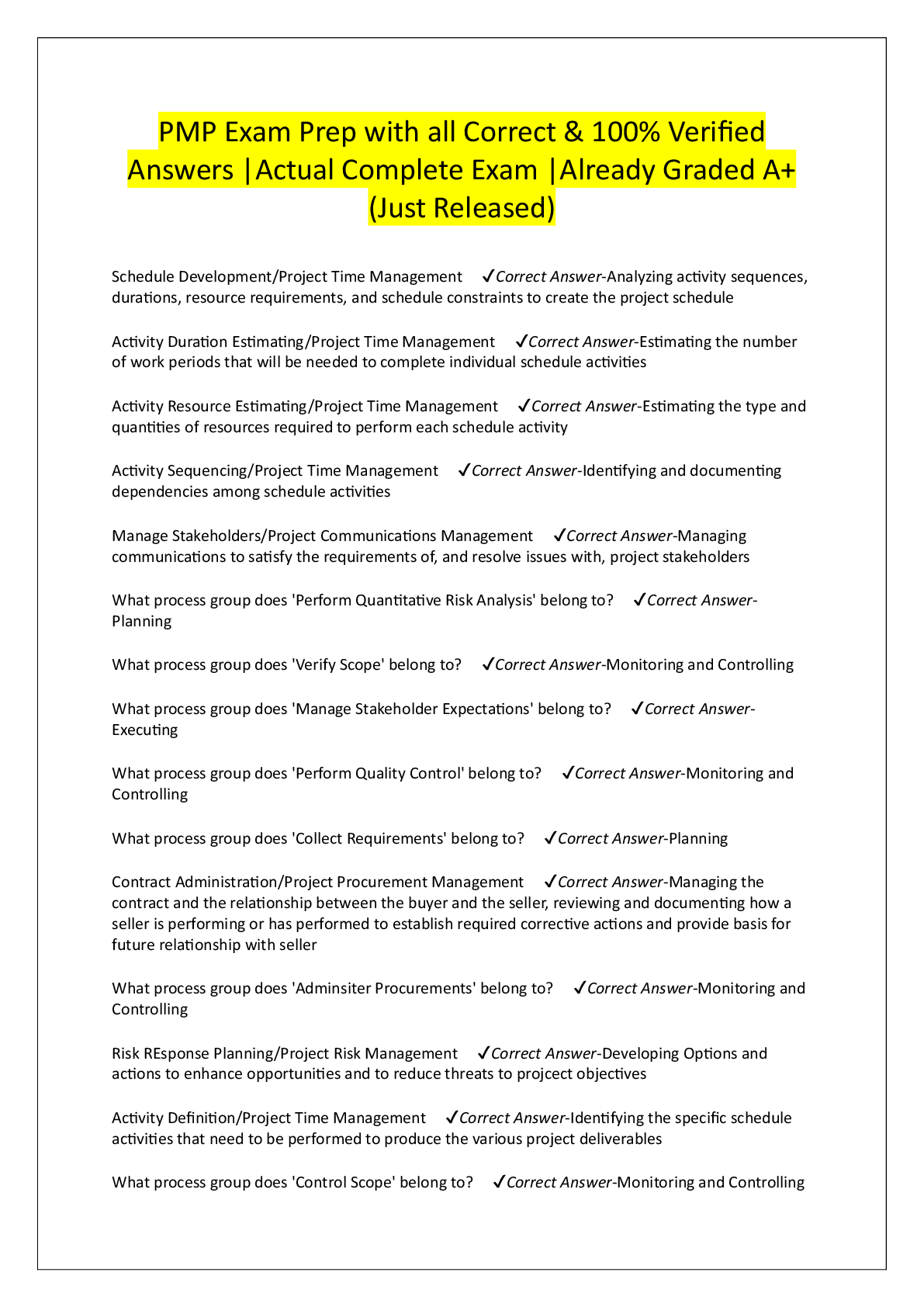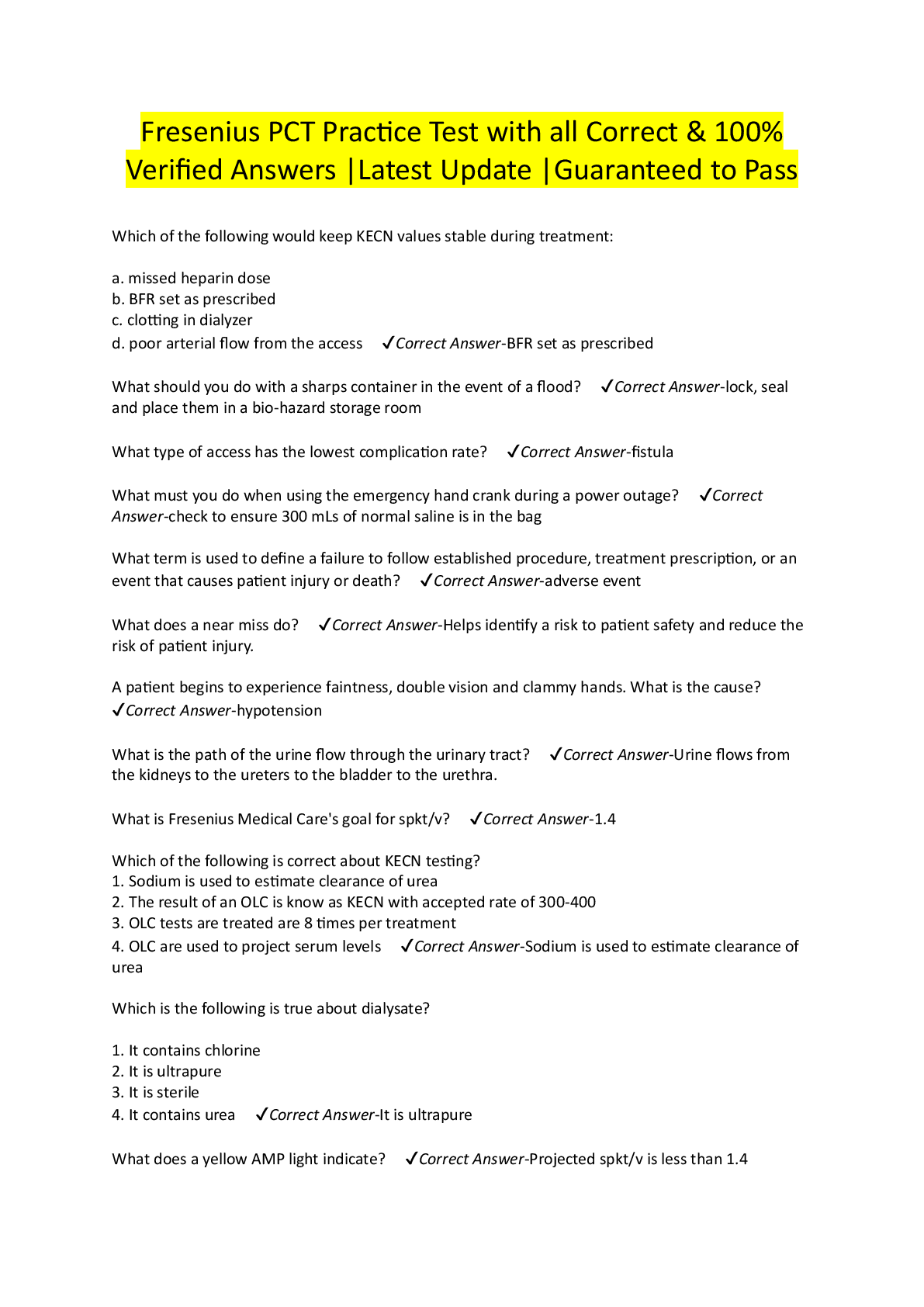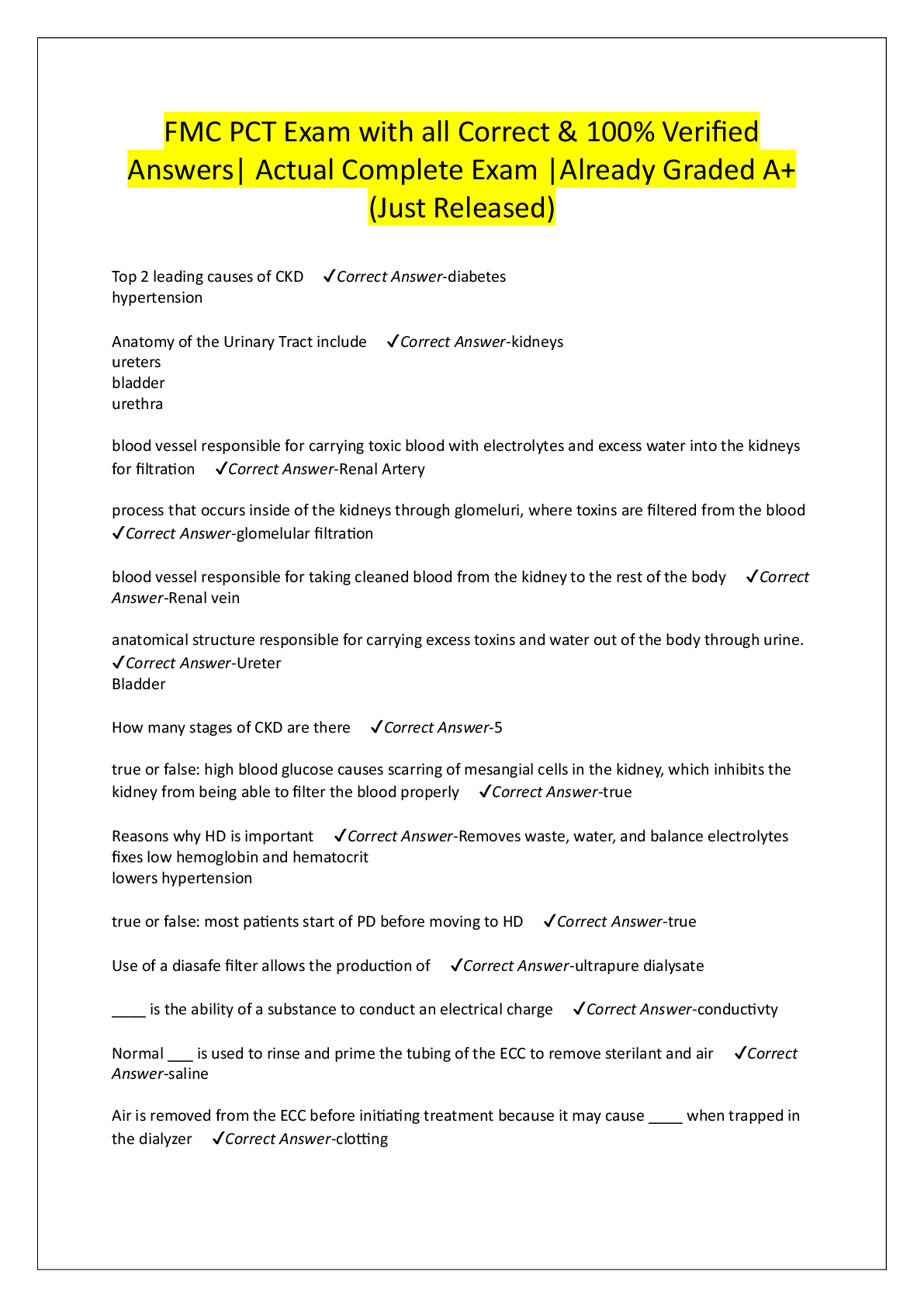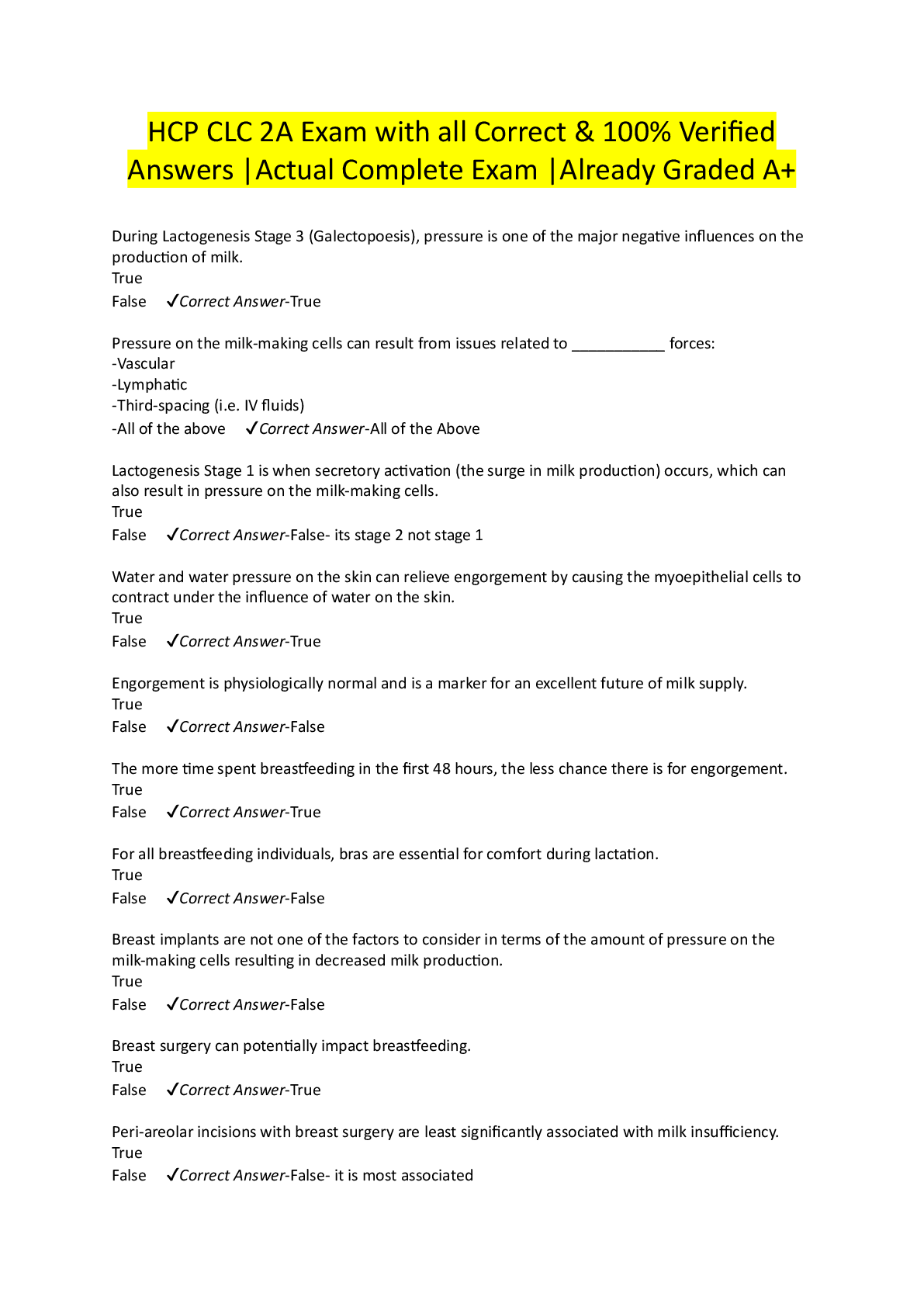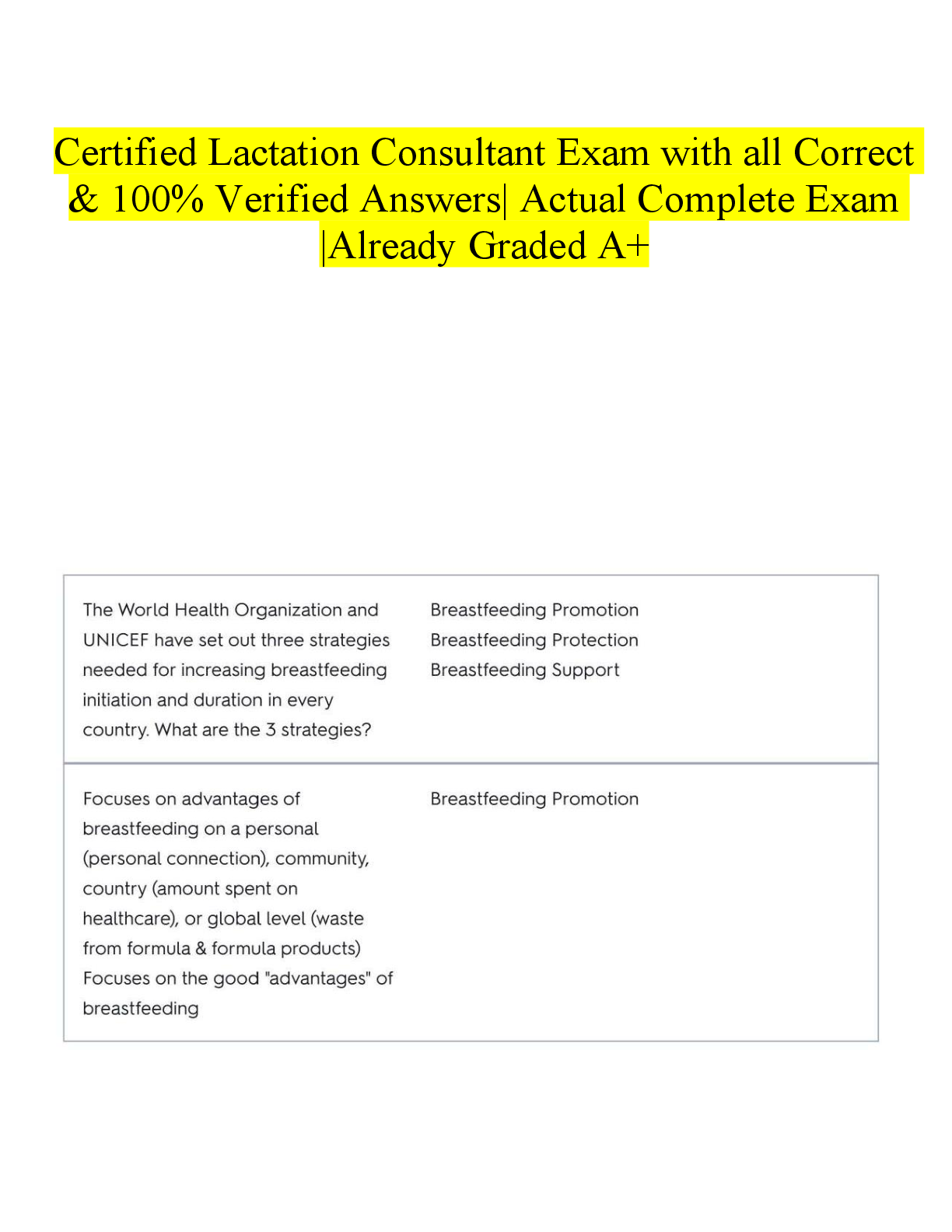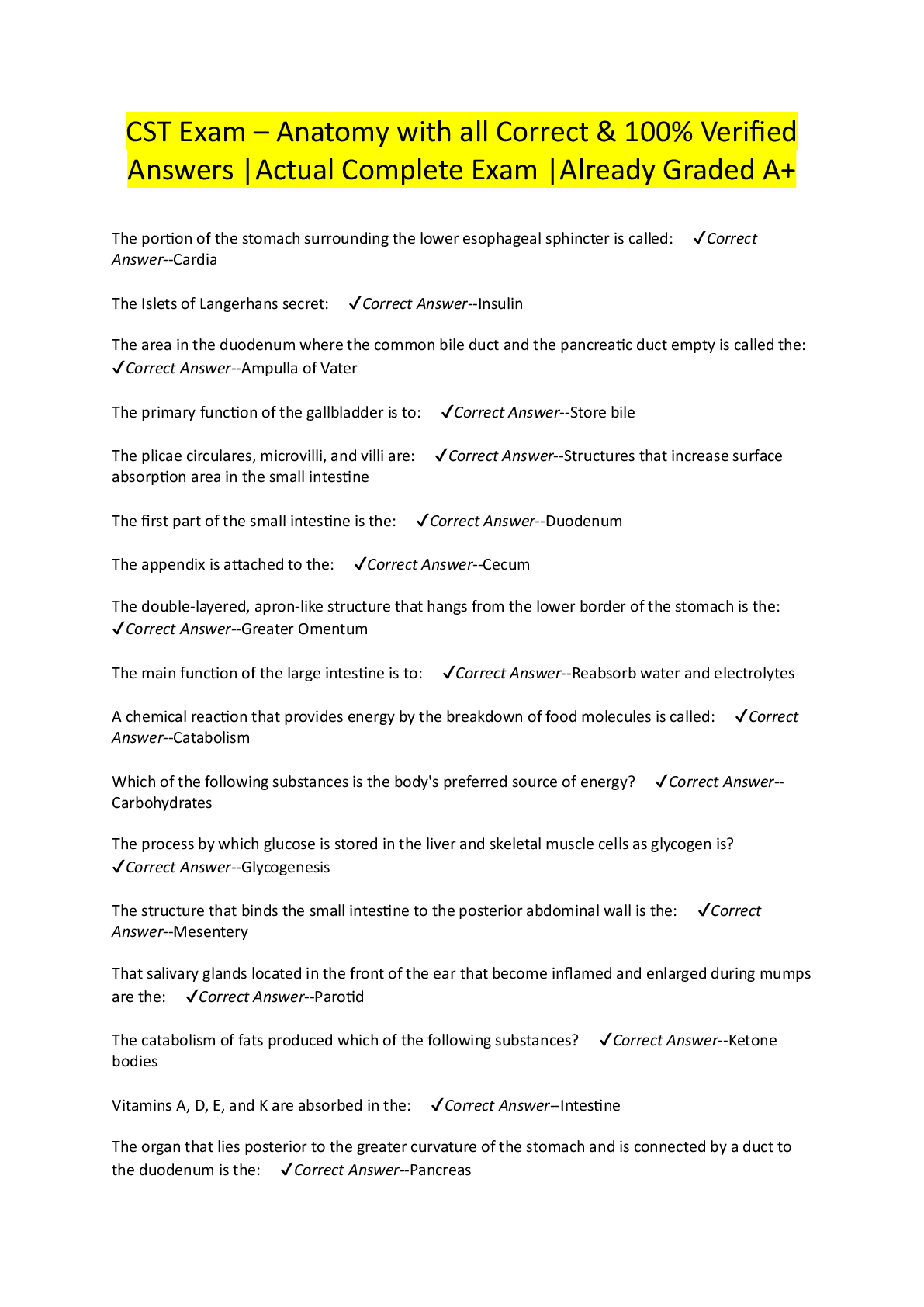*NURSING > EXAM > NURSING 1950 Mental Health Module 1 (GRADED A+) Questions and Answers Solution | GUARANTEED ACE (All)
NURSING 1950 Mental Health Module 1 (GRADED A+) Questions and Answers Solution | GUARANTEED ACE
Document Content and Description Below
NURSING 1950 Mental Health Module 1 (GRADED A+) Questions and Answers Solution A staff nurse completes orientation to a psychiatric unit. This nurse may expect an advanced practice nurse to perfor ... m which additional intervention? Prescribe psychotropic medication. In most states, prescriptive privileges are granted to master's-prepared nurse practitioners who have taken special courses on prescribing medication. The nurse prepared at the basic level is permitted to perform mental health assessments, establish relationships, and provide individualized care planning. 1. When a nursing student expresses concerns about how mental health nurses "lose all their nursing skills," the best response by the mental health nurse is: "Psychiatric nurses use complex communication skills as well as critical thinking to solve multidimensional problems. I am challenged by those situations." The practice of psychiatric nursing requires a different set of skills than medical-surgical nursing, though there is substantial overlap. Psychiatric nurses must be able to help patients with medical as well as mental health problems, reflecting the holistic perspective these nurses must have. Nurse-patient ratios and workloads in psychiatric settings have increased, just like other specialties. Psychiatric nursing involves clinical practice, not just documentation. Psychosocial pain and suffering are as real as physical pain and suffering. 2. When a new bill introduced in Congress reduces funding for care of persons with mental illness, a group of nurses writes letters to their elected representatives in opposition to the legislation. Which role have the nurses fulfilled? Advocacy An advocate defends or asserts another's cause, particularly when the other person lacks the ability to do that for self. Examples of individual advocacy include helping patients understand their rights or make decisions. On a community scale, advocacy includes political activity, public speaking, and publication in the interest of improving the human condition. Since funding is necessary to deliver quality programming for persons with mental illness, the letter- writing campaign advocates for that cause on behalf of patients who are unable to articulate their own needs. 3. Which comment best indicates that a patient perceived the nurse was caring? "My nurse: “Spends time listening to me talk about my problems. That helps me feel like I am not alone." Caring evidences empathetic understanding as well as competency. It helps change pain and suffering into a shared experience, creating a human connection that alleviates feelings of isolation. The distracters give examples of statements that demonstrate advocacy or giving advice. 4. Which assessment finding most clearly indicates that a patient may be experiencing a mental illness? The patient: Reports a consistently sad, discouraged, and hopeless mood. The correct response describes a mood alteration, which reflects mental illness. The distracters describe behaviors that are mentally healthy or within the usual scope of human experience. 5. Which finding best indicates that the goal "Demonstrate mentally healthy behavior" was achieved? A patient: Sees self as capable of achieving ideals and meeting demands. The correct response describes an adaptive, healthy behavior. The distracters describe maladaptive behaviors. 6. A nurse encounters an unfamiliar psychiatric disorder on a new patient's admission form. Which resource should the nurse consult to determine criteria used to establish this diagnosis? Diagnostic and Statistical Manual of Mental Disorders (DSM-5) The DSM-5 gives the criteria used to diagnose each mental disorder. The distracters may not contain diagnostic criteria for a psychiatric illness. 7. A nurse wants to find a description of diagnostic criteria for anxiety disorders. Which resource would have the most complete information? Diagnostic and Statistical Manual of Mental Disorders (DSM-5) The DSM-5 details the diagnostic criteria for psychiatric clinical conditions. The other references are good resources but do not define the diagnostic criteria. 8. Which individual is demonstrating the highest level of resilience? One who: Takes a temporary job to maintain financial stability after loss of a permanent job. Resilience is closely associated with the process of adapting and helps people facing tragedies, loss, trauma, and severe stress. It is the ability and capacity for people to secure the resources they need to support their well-being. Repression and depression are unhealthy. Living in a shelter for two years shows a failure to move forward after a tragedy. See related audience response question. 9. Complete this analogy. NANDA: clinical judgment: NIC: Nursing actions Analogies show parallel relationships. NANDA, the North American Nursing Diagnosis Association, identifies diagnostic statements regarding human responses to actual or potential health problems. These statements represent clinical judgments. NIC (Nursing Interventions Classification) identifies actions provided by nurses that enhance patient outcomes. Nursing care activities may be direct or indirect. 10. A college student said, "Most of the time I'm happy and feel good about myself. I have learned that what I get out of something is proportional to the effort I put into it." Which number on this mental health continuum should the nurse select? Mental Illness Mental Health 1 2 3 4 5 5 The student is happy and has an adequate self-concept. The student is reality-oriented, works effectively, and has control over own behavior. Mental health does not mean that a person is always happy. 11. Which disorder is a culture-bound syndrome? Running amok Culture-bound syndromes occur in specific sociocultural contexts and are easily recognized by people in those cultures. A syndrome recognized in parts of Southeast Asia is running amok, in which a person (usually a male) runs around engaging in furious, almost indiscriminate violent behavior. 12. The Diagnostic and Statistical Manual of Mental Disorders (DSM-5) classifies: Mental disorders people have The DSM-5 classifies disorders people have rather than people themselves. The terminology of the tool reflects this distinction by referring to individuals with a disorder rather than as a "schizophrenic" or "alcoholic," for example. Deviant behavior is not generally considered a mental disorder. Present disability or distress is only one aspect of the diagnosis. 13. A citizen at a community health fair asks the nurse, "What is the most prevalent mental disorder in the United States?" Select the nurse's best response. Alzheimer's disease The 12-month prevalence for Alzheimer's disease is 10% for persons older than 65 and 50% for persons older than 85. The prevalence of schizophrenia is 1.1% per year. The prevalence of bipolar disorder is 2.6%. Dissociative fugue is a rare disorder. See related audience response question. 14. In the majority culture of the United States, which individual has the greatest risk to be labeled mentally ill? One who: Describes hearing God's voice speaking. The question asks about risk. Hearing voices is generally associated with mental illness, but in charismatic religious groups, hearing the voice of God or a prophet is a desirable event. Cultural norms vary, which makes it more difficult to make an accurate diagnosis. The individuals described in the other options are less likely to be labeled mentally ill. 15. A patient's relationships are intense and unstable. The patient initially idealizes the significant other and then devalues him or her, resulting in frequent feelings of emptiness. This patient will benefit from interventions to develop which aspect of mental health? Fulfilling relationships The information given centers on relationships with others that are described as intense and unstable. The relationships of mentally healthy individuals are stable, satisfying, and socially integrated. Data are not present to describe work effectiveness, communication skills, or activities. 16. Which belief will best support a nurse's efforts to provide patient advocacy during a multidisciplinary patient care planning session? Assessment findings in mental disorders reflect a person's cultural patterns. A nurse who understands that a patient's symptoms are influenced by culture will be able to advocate for the patient to a greater degree than a nurse who believes that culture is of little relevance. The distracters are untrue statements. 17. A nurse is part of a multidisciplinary team working with groups of depressed patients. Half the patients receive supportive interventions and antidepressant medication. The other half receives only medication. The team measures outcomes for each group. Which type of study is evident? Clinical epidemiology Clinical epidemiology is a broad field that addresses studies of the natural history (or what happens if there is no treatment and the problem is left to run its course) of an illness, studies of diagnostic screening tests, and observational and experimental studies of interventions used to treat people with the illness or symptoms. Prevalence refers to numbers of new cases. Co-morbidity refers to having more than one mental disorder at a time. Incidence refers to the number of new cases of mental disorders in a healthy population within a given period. See related audience response question. 18. The spouse of a patient diagnosed with schizophrenia says, "I don't understand how events from childhood have anything to do with this disabling illness." Which response by the nurse will best help the spouse understand the cause of this disorder? "Research shows that this condition more likely has a biological basis." Many of the most prevalent and disabling mental disorders have strong biological influences. Genetics are only one part of biological factors. Empathy does not address increasing the spouse's level of knowledge about the cause of the disorder. The other distracters are not established facts. 19. A category 5 tornado occurred in a community of 400 people resulting in destruction of many homes and businesses. In the 2 years after this disaster, 140 individuals were diagnosed with posttraumatic stress disorder (PTSD). Which term best applies to these newly diagnosed cases? Incidence Incidence refers to the number of new cases of mental disorders in a healthy population within a given period of time. Prevalence describes the total number of cases, new and existing, in a given population during a specific period of time, regardless of when they became ill. Parity refers to equivalence, and legislation required insurers that provide mental health coverage to offer annual and lifetime benefits at the same level provided for medical/surgical coverage. Co-morbidity refers to having more than one mental disorder at a time. 20. Which component of treatment of mental illness is specifically recognized by Quality and Safety Education for Nurses (QSEN)? Care is centered on the patient. The key areas of care promoted by QSEN are patient-centered care, teamwork and collaboration, evidence-based practice, quality improvement, safety, and informatics. 21. Select the best response for the nurse who receives a question from another health professional seeking to understand the difference between a Diagnostic and Statistical Manual of Mental Disorders (DSM-5) diagnosis and a nursing diagnosis. "The DSM-5 diagnosis guides medical treatment, whereas the nursing diagnosis offers a framework for identifying interventions for issues a patient is experiencing." The medical diagnosis is concerned with the patient's disease state, causes, and cures, whereas the nursing diagnosis focuses on the patient's response to stress and possible caring interventions. Both tools consider culture. The DSM-5 is multiaxial. Nursing diagnoses also consider potential problems. 22. Which nursing intervention below is part of the scope of an advanced practice psychiatric/mental health nurse only? Psychotherapy Psychotherapy is part of the scope of practice of an advanced practice nurse. The distracters are within a staff nurse's scope of practice. 23. An experienced nurse says to a new graduate, "When you've practiced as long as I have, you instantly know how to take care of psychotic patients." What information should the new graduate consider when analyzing this comment? (Select all that apply.) -The experienced nurse may have lost sight of patients' individuality, which may compromise the integrity of practice. -New research findings should be integrated continuously into a nurse's practice to provide the most effective care. Evidence-based practice involves using research findings and standards of care to provide the most effective nursing care. Evidence is continuously emerging, so nurses cannot rely solely on experience. The effective nurse also maintains respect for each patient as an individual. Overgeneralization compromises that perspective. Intuition and trial and error are unsystematic approaches to care. 24. Which findings are signs of a person who is mentally healthy? (Select all that apply.) -Says, "I have some weaknesses, but I feel I'm important to my family and friends." -Considers past experiences when deciding about the future. -Experiences feelings of conflict related to changing jobs. Mental health is a state of well-being in which each individual is able to realize his or her own potential, cope with the normal stresses of life, work productively, and make a contribution to the community. Mental health provides people with the capacity for rational thinking, communication skills, learning, emotional growth, resilience, and self-esteem. 25. The intervention that can be practiced by an advanced practice registered nurse in psychiatric mental health but cannot be practiced by a basic level registered nurse is: Psychotherapy 26. Which statement best describes a major difference between a DSM-5 diagnosis and a nursing diagnosis? The DSM-5 is associated with present symptoms, whereas a nursing diagnosis considers past, present, and potential responses to actual mental health problems 27. Epidemiological studies contribute to improvements in care for individuals with mental disorders by: Identifying who in the general population will develop a specific disorder 28. A nursing student new to psychiatric mental health nursing asks a peer what resources he can use to figure out which symptoms are present in a specific psychiatric disorder. The best answer would be: DSM-5 29. Which statement about mental illness is true? Mental illness changes with culture, time in history, political systems, and the groups defining it. 30. A male client who has a diagnosis of generalized anxiety disorder (GAD) is seen in the emergency room with complaints of chest pain, shortness of breath, and inability to concentrate, along with feelings of overwhelming anxiety. The nurse uses Maslow's theory to triage the client's complaints, knowing that which complaint must be addressed first? Shortness of breath 31. According to Freud's theory, a baby who is crying in response to wanting to be held by his mother is an example of which part of the personality's control over behavior? Id 32. According to the theorist Erik Erikson, an individual strives to actualize his identity, is most productive, and demonstrates guidance of and concern for others with a core task of caring during which stage of psychosocial development? Middle adulthood (25-65) 33. During a therapy session, a client is asked to respond to a word with the first word or phrase that comes to mind. What term is commonly used to refer to this technique? Free association 34. Carl Jung was the founder of analytical psychotherapy; he differed from Freud in that he believed that the mind was divided into three levels: the conscious ego, the personal unconscious, and the: Collective unconscious 35. Jean Piaget's theory of cognitive development identifies an interrelationship between the and the functions in the development of one's personality. Intellectual; emotional 36. How many stages of the human life cycle did Erik Erikson identify? Eight 37. A 4-year-old client in a pediatric unit is imitating the actions of the nurse. The nurse knows, according to Erik Erikson's theory, that this child is displaying a characteristic seen during which developmental stage? Genital-locomotor 38. Humanistic theories are important to health care because these theories serve as the foundation for the concept of: Holistic care 39. During a conversation with a male client, he voices that he really appreciates his family, likes his job, and enjoys groups in which he volunteers. According to Maslow's theory, what is this client experiencing? Self-actualization 40. The nurse knows that the major concept of the systems theory is that individuals are viewed as functioning: Within a set of interacting and related units 41. Group therapy, which assists in relieving emotional distress and encourages psychological and behavioral changes, was developed following World War II as a result of a: Shortage of psychiatrists 42. Betty Neuman developed the nursing theory that promotes nursing interventions to assist individuals in reaching and maintaining the highest level of wellness possible. What is this theory known as? Systems model 43. Following an argument with his daughter, a father takes away her phone privileges. He later feels guilty about the argument and asks her if she would like to go shopping for new clothes. What is this defense mechanism known as? Restitution 44. A female client with low self-esteem tries to dress and act like the nurse who cares for her in an outpatient clinic setting. This behavior is an example of which defense mechanism? Identification 45. During group therapy, certain group change mechanisms may be observed. When an individual engages in helping others, resulting in improvement in his or her own self-esteem, which group change mechanism has the individual experienced? Altruism 46. A client is granted permission to watch a favorite television show in the evening because she participated in an occupational therapy activity. Her therapist bases this on theory. Behavioral 47. A client does not participate in group sessions due to feeling inferior to others in the group. Based on cognitive theory, he would be directed to: Recognize and change his negative thoughts 48. Which of the following assessment parameters is a priority in a biobehavioral model of practice? Blood chemistry 49. The nurse who feels the most beneficial part of the client's inpatient stay is the establishment of an interpersonal relationship with the nurse is an example of which nursing theorist? Peplau 50. Freud's psychoanalytical theory states that an adult is more likely to be mentally healthy if there is a balance between which parts of the mind? (Select all that apply.) -Id -Ego -Super-ego 51. Psychobiology theory considers the causes of mental illness to be which of the following? (Select all that apply.) -Genetics -Neurotransmitter activity -Immune system dysfunction 52. Freud believed that an individual's personality developed through stages of sexual instinct from birth to adulthood. This is known as the theory of personality development. Psychosexual 53. Dr. Sigmund Freud believed that a person's unconscious thoughts and emotions affect his or her behavior. The now well-known therapy that he developed to explore an individual's unconscious thoughts is referred to as . Psychoanalysis 54. Which intervention demonstrates the nurse's understanding of what guides effective nursing care with a diverse patient population? Identifying the cultural norms of the population being served 55. Which statement indicates the beliefs and values that tend to be representative of a member of an indigenous culture? Select all that apply. "I've reinforced the importance of taking medications at the time they are prescribed." "The patient believes that illness is a result of being out of harmony with nature." "Spending money on medicine for his diabetes is not a comfortable concept for my patient." "We discussed the patient's needs regarding warding off evil spirits before her surgery." 56. Which assessment questions will support effective communication with a patient who recently emigrated from an Asian country? Select all that apply. -"What do you call this kind of pain?" - "What do you think is causing your pain?" -"How do you think your pain should be treated?" -"Do you consider this kind of pain a serious problem?" 57. When considering culturally competent care for a Muslim patient diagnosed with cardiac problems, which intervention is particularly important to implement initially when a low fat diet is prescribed? Identifying dietary considerations 58. Which statement by the nurse demonstrates ethnocentrism toward the Hispanic patient? "I'm sure we can do something to make your symptoms more manageable." 59. Ling has a nursing diagnosis of risk for other-directed violence. Ling's Eastern culture family is having difficulty coping with the illness due to their beliefs. A favorable therapeutic modality for this patient might include: Family therapy 60. A charge nurse is educating a new nurse; the charge nurse asks which of the following is the best guide for better patient care? The new nurse shows understanding when she replies with Culture, since it is a patterned way of thinking and acting 61. Which of the following statements indicates a student nurse understands Eastern tradition? Eastern tradition gives value to persons in need of healthcare considered to be vulnerable and require protection from cruel truth 62. Which of the following statements is accurate, in order to qualify as a minority status? Cultures must socially define them as a differentiated group 63. A nurse is aware of the patterns of nonverbal communication in different cultures. When assessing a group of patients from the United States, what does the nurse consider regarding eye contact? It is associated with attentiveness 64. A nurse provides discharge instructions to a patient of Middle Eastern heritage who immigrated to this country 1 year ago. Which strategy is most important to assure the patient's understanding of the instructions? Use a professional interpreter when providing instruction 65. When assessing and planning care for a client who has recently arrived in the United States from China, the nurse should be alert to the possibility that the client's explanatory model for his illness reflects which cultural concept? Imbalance 66. Which nursing actions demonstrate cultural competence? Select all that apply. -Planning mealtime around the patient's prayer schedule -Helping a patient to visit with the hospital chaplain -Researching foods that a lacto-ovo-vegetarian patient will eat -Providing time for a patient's spiritual healer to visit 67. Intergenerational conflict may arise in immigrant families because the process of acculturation may be: Easier for children 68. A nurse states, "I am so frustrated trying to communicate with clients when they insist on speaking in their language instead of English. I think if people want to live here, they ought to have to speak our language and act like we do!" Which response by a peer best promotes culturally competent care? (Select all that apply) -"What you are saying is actually considered cultural imposition, which is imposing our own culture onto someone from a different culture." -"When their ability to speak and understand English is very limited, we need to have an interpreter present to make sure they can make their needs and feelings known." 69. Why do we need transcultural nursing care in our healthcare system? To provide an individualized & holistic patient care 70. Why have legal suits been increasing in the healthcare system recently? (Select all that apply) -A rise in the Cultural conflict -Negligence -Imposition of health care practices on the clients 71. While discussing folk medicine with an Amish client, the nurse remarked: "In the long run, Western medicine is best!" This remark is an example of: Ethnocentrism 72. The learned, shared and transmitted values, beliefs, norms, and lifeways of a particular group that guides their thinking, decisions, and actions in patterned ways is defined as: Culture 73. Care that includes the nurse learning about cultural issues involved in the patient's health care belief system and enable patients and families to achieve meaningful and supportive care is known as Culturally competent care 74. What question would help assess patient's generic care beliefs? Could you give some examples of healing or caring practices that come from your cultural group? 75. A nurse teaches a Filipino American patient that although garlic may lower his blood pressure, he still needs to take the antihypertensive medications that are prescribed. This is an example of which mode of nursing care? Cultural care accommodation or negotiation 76. A nurse wishes to develop cultural competence. Which of the following actions should the nurse take first? Consider how the nurses own personal beliefs and decisions are reflective of his or her culture 77. A key principle in recognizing cultural differences is to observe . Carefully observe non-verbal communication 78. An American nurse tries to speak with a Korean client who cannot understand the English language. To effectively communicate to a client with a different language, which of the following should the nurse implement? Have an interpreter to translate 79. A psychiatric nurse best applies the ethical principle of autonomy by: Exploring alternative solutions with a patient, who then makes a choice. Autonomy is the right to self-determination, that is, to make one's own decisions. By exploring alternatives with the patient, the patient is better equipped to make an informed, autonomous decision. The distracters demonstrate beneficence, fidelity, and justice. 80. A nurse finds a psychiatric advance directive in the medical record of a patient experiencing psychosis. The directive was executed during a period when the patient was stable and competent. The nurse should: Ensure that the directive is respected in treatment planning. The nurse has an obligation to honor the right to self-determination. An advanced psychiatric directive supports that goal. Since the patient is currently psychotic, the terms of the directive now apply. 81. Two hospitalized patients fight whenever they are together. During a team meeting, a nurse asserts that safety is of paramount importance, so treatment plans should call for both patients to be secluded to keep them from injuring each other. This assertion: Violates the civil rights of both patients. Patients have a right to treatment in the least restrictive setting. Safety is important, but less restrictive measures should be tried first. Unnecessary seclusion may result in a charge of false imprisonment. Seclusion violates the patient's autonomy. The principle by which the nurse is motivated is beneficence, not justice. The tort represented is false imprisonment. 82. In a team meeting a nurse says, "I'm concerned about whether we are behaving ethically by using restraint to prevent one patient from self-mutilation, while the care plan for another self-mutilating patient requires one-on-one supervision." Which ethical principle most clearly applies to this situation? Justice The nurse is concerned about justice, that is, fair distribution of care, which includes treatment with the least restrictive methods for both patients. Beneficence means promoting the good of others. Autonomy is the right to make one's own decisions. Fidelity is the observance of loyalty and commitment to the patient. 83. Select the example of a tort. A nurse gives a PRN dose of an antipsychotic drug to an agitated patient because the unit is short- staffed. A tort is a civil wrong against a person that violates his or her rights. Giving unnecessary medication for the convenience of staff controls behavior in a manner similar to secluding a patient; thus, false imprisonment is a possible charge. The other options do not exemplify torts. 84. What is the legal significance of a nurse's action when a patient verbally refuses medication and the nurse gives the medication over the patient's objection? The nurse: Can be charged with battery Battery is an intentional tort in which one individual violates the rights of another through touching without consent. Forcing a patient to take medication after the medication was refused constitutes battery. The charge of battery can be brought against the nurse. The medication may not necessarily harm the patient; harm is a component of malpractice. 85. Which nursing intervention demonstrates false imprisonment? A patient has been irritating and attention-seeking much of the day. A nurse escorts the patient down the hall saying, "Stay in your room, or you'll be put in seclusion." False imprisonment involves holding a competent person against his or her will. Actual force is not a requirement of false imprisonment. The individual needs only to be placed in fear of imprisonment by someone who has the ability to carry out the threat. If a patient is not competent (confused), then the nurse should act with beneficence. Patients admitted involuntarily should not be allowed to leave without permission of the treatment team. 86. Which patient meets criteria for involuntary hospitalization for psychiatric treatment? The patient who: Threatens to harm self and others. Involuntary hospitalization protects patients who are dangerous to themselves or others and cannot care for their own basic needs. Involuntary commitment also protects other individuals in society. The behaviors described in the other options are not sufficient to require involuntary hospitalization. 87. A nurse prepares to administer a scheduled injection of haloperidol decanoate (Haldol depot) to an outpatient with schizophrenia. As the nurse swabs the site, the patient shouts, "Stop! I don't want to take that medicine anymore. I hate the side effects." Select the nurse's best action. Stop the medication administration procedure and say to the patient, "Tell me more about the side effects you've been having." Patients with mental illness retain their civil rights unless there is clear, cogent, and convincing evidence of dangerousness. The patient in this situation presents no evidence of dangerousness. The nurse, as an advocate and educator, should seek more information about the patient's decision and not force the medication. 88. A nurse is concerned that an agency's policies are inadequate. Which understanding about the relationship between substandard institutional policies and individual nursing practice should guide nursing practice? Agency policies do not exempt an individual nurse of responsibility to practice according to professional standards of nursing care. Nurses are professionally bound to uphold standards of practice regardless of lesser standards established by a health care agency or a state. Conversely, if the agency standards are higher than standards of practice, the agency standards must be upheld. The courts may seek to establish the standard of care through the use of expert witnesses when the issue is clouded. 89. A newly admitted acutely psychotic patient is a private patient of the medical director and a private- pay patient. To whom does the psychiatric nurse assigned to the patient owe the duty of care? Patient Although the nurse is accountable to the health care provider, the agency, the patient, and the profession, the duty of care is owed to the patient. 90. Which action by a nurse constitutes a breach of a patient's right to privacy? Releasing information to the patient's employer without consent Release of information without patient authorization violates the patient's right to privacy. The other options are acceptable nursing practices. See relationship to audience response question. 91. An adolescent hospitalized after a violent physical outburst tells the nurse, "I'm going to kill my father, but you can't tell anyone." Select the nurse's best response. "I am obligated to share that information with the treatment team." Breach of nurse-patient confidentiality does not pose a legal dilemma for nurses in these circumstances because a team approach to delivery of psychiatric care presumes communication of patient information to other staff members to develop treatment plans and outcome criteria. The patient should also know that the team has a duty to warn the father of the risk for harm. 92. A voluntarily hospitalized patient tells the nurse, "Get me the forms for discharge. I want to leave now." Select the nurse's best response. "I will get them for you, but let's talk about your decision to leave treatment." A voluntarily admitted patient has the right to demand and obtain release in most states. However, as a patient advocate, the nurse is responsible for weighing factors related to the patient's wishes and best interests. By asking for information, the nurse may be able to help the patient reconsider the decision. Facilitating discharge without consent is not in the patient's best interests before exploring the reason for the request. 93. Insurance will not pay for continued private hospitalization of a mentally ill patient. The family considers transferring the patient to a public hospital but expresses concern that the patient will not get any treatment if transferred. Select the nurse's most helpful reply. “By law, treatment must be provided. Hospitalization without treatment violates patients’ rights.” The right to medical and psychiatric treatment was conferred on all patients hospitalized in public mental hospitals with the enactment of the federal Hospitalization of Mentally Ill Act in 1964. 94. Which individual with mental illness may need emergency or involuntary admission? The individual who: Throws a heavy plate at a waiter at the direction of command hallucinations. Throwing a heavy plate is likely to harm the waiter and is evidence of dangerousness to others. This behavior meets the criteria for emergency or involuntary hospitalization for mental illness. The behaviors in the other options evidence mental illness but not dangerousness. See related audience response question. 95. A patient in alcohol rehabilitation reveals to the nurse, "I feel terrible guilt for sexually abusing my 6- year-old before I was admitted." Select the nurse's most important action. Anonymously report the abuse by phone to the local child protection agency Laws regarding child abuse reporting discovered by a professional during the suspected abuser's alcohol or drug treatment differ by state. Federal law supersedes state law and prohibits disclosure without a court order except in instances in which the report can be made anonymously or without identifying the abuser as a patient in an alcohol or drug treatment facility. 96. A family member of a patient with delusions of persecution asks the nurse, "Are there any circumstances under which the treatment team is justified in violating a patient's right to confidentiality?" The nurse should reply that confidentiality may be breached: If the patient threatens the life of another person. The duty to warn a person whose life has been threatened by a psychiatric patient overrides the patient's right to confidentiality. The right to confidentiality is not suspended at the discretion of the therapist or for legal investigations. 97. A new antidepressant is prescribed for an elderly patient with major depression, but the dose is more than the usual geriatric dose. The nurse should: Withhold the medication and confer with the health care provider. The dose of antidepressants for elderly patients is often less than the usual adult dose. The nurse should withhold the medication and consult the health care provider who wrote the order. The nurse’s duty is to practice according to professional standards as well as intervene and protect the patient. 98. A patient diagnosed with schizophrenia believes a local minister stirred evil spirits. The patient threatens to bomb a local church. The psychiatrist notifies the minister. Select the answer with the correct rationale. The psychiatrist: Demonstrated the duty to warn and protect. It is the health care professional's duty to warn or notify an intended victim after a threat of harm has been made. Informing a potential victim of a threat is a legal responsibility of the health care professional. It is not a violation of confidentiality. [Show More]
Last updated: 3 years ago
Preview 1 out of 17 pages
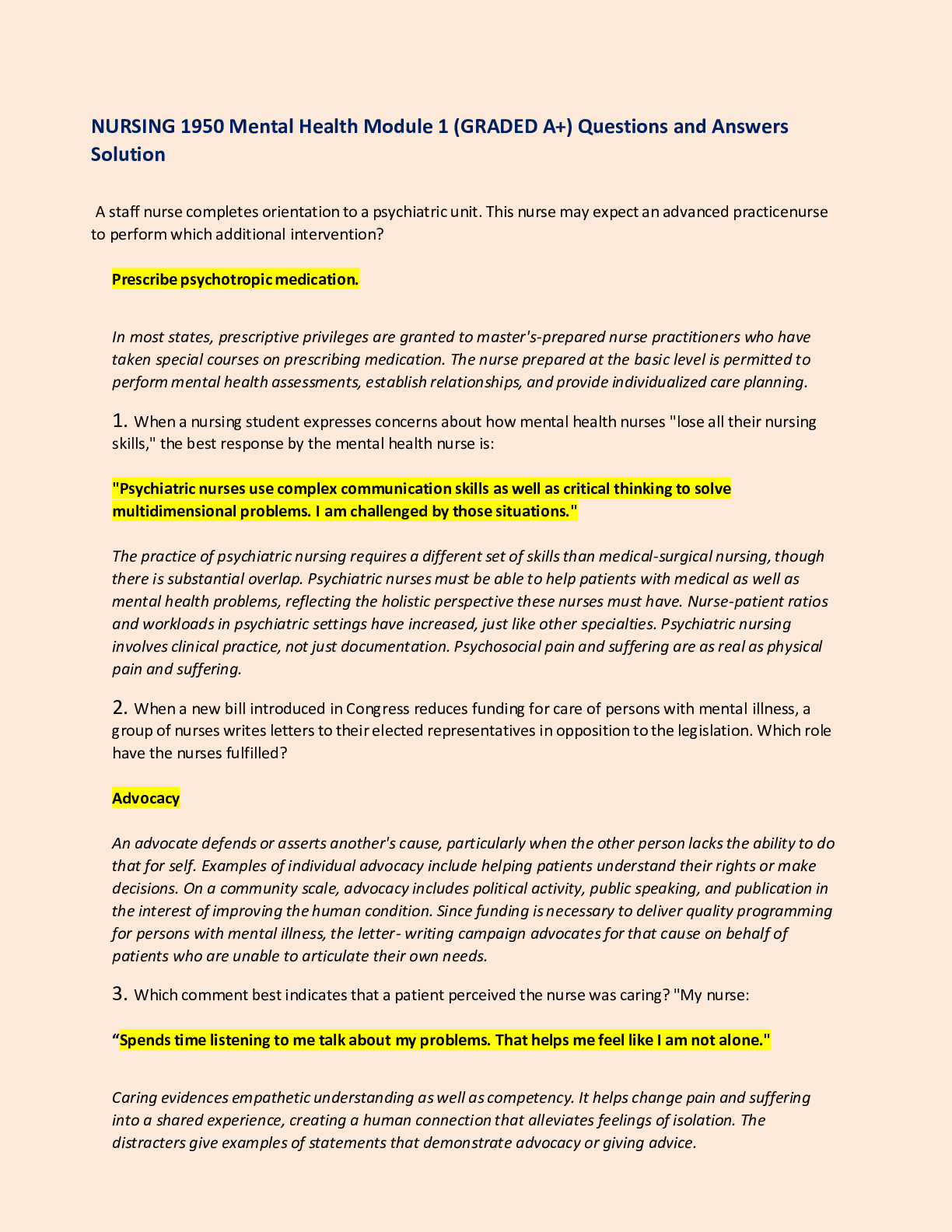
Buy this document to get the full access instantly
Instant Download Access after purchase
Buy NowInstant download
We Accept:

Also available in bundle (1)
Click Below to Access Bundle(s)

Nursing 1950 Mental Health Module BUNDLE Exams 1-6 with Questions and Answers- SRTC
Nursing 1950 Mental Health Module BUNDLE Exams 1-6 with Questions and Answers- SRTC
By Prof. Goodluck 4 years ago
$14.5
6
Reviews( 0 )
$15.00
Can't find what you want? Try our AI powered Search
Document information
Connected school, study & course
About the document
Uploaded On
Jun 24, 2021
Number of pages
17
Written in
All
Additional information
This document has been written for:
Uploaded
Jun 24, 2021
Downloads
0
Views
123


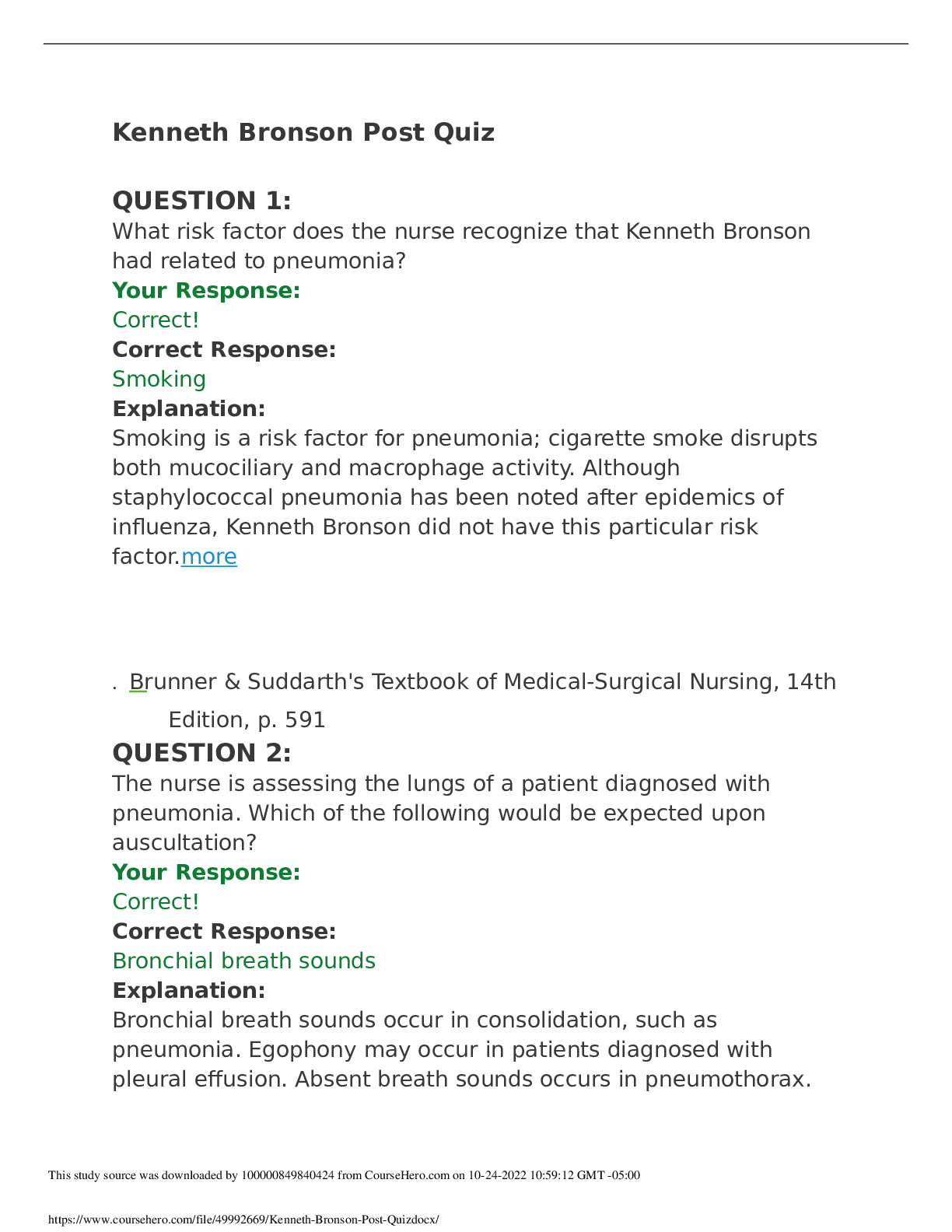



 Questions and Answers 100% VERIFIED.png)
 Questions and Answers 100% correct Solutions.png)



